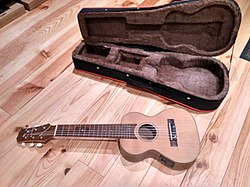 | |
| Other names | Guitarlele, Guilele, Ukitar, Soprano Guitar, Petite Guitar, Kīkū' |
|---|---|
| Classification | String instrument |
| Related instruments | |
A guitalele (sometimes spelled guitarlele or guilele), also called a ukitar,[1] or kīkū,[2][3] is a guitar-ukulele hybrid, that is, "a 1/4 size" guitar, a cross between a classical guitar and a tenor or baritone ukulele.[4] The guitalele combines the portability of a ukulele, due to its small size, with the six single strings and resultant chord possibilities of a classical guitar. It may include a built-in microphone that permits playing the guitalele either as an acoustic guitar or connected to an amplifier. The guitalele is variously marketed (and used) as a travel guitar or children's guitar. It is essentially a modern iteration of the Quint guitar.[5]

A guitalele is the size of a ukulele, and is commonly played like a guitar transposed up to “A” (that is, up a 4th, or like a guitar with a capo on the fifth fret). This gives it tuning of ADGCEA, with the top four strings tuned like a low G ukulele.[6] This is the same as the tuning of the requinto guitar, although the latter are typically larger than a guitalele, and as the most common tuning for the guitarrón mexicano, albeit at a higher octave.
Several guitar and ukulele manufacturers market guitaleles, including Yamaha Corporation's GL-1 Guitalele,[7][8] Cordoba's Guilele[9] and Mini,[10] Koaloha's D-VI 6-string tenor ukulele,[11] Mele's Guitarlele,[12] Kanilea's GL6 Guitarlele[13] and Islander GL6,[14] Luna's 6-string baritone ukulele,[15] the Yudelele, the Lichty Kīkū,[2] the Kinnard Kīkū,[3] and the Gretsch guitar-ukulele.[16]
Some manufacturers' (e.g., Luna) use of the term "6-string ukulele" (or the like) in describing their six-string, six-course guitaleles can lead to confusion with the common six-string, four-course ukuleles that are typically referred to by the same name.[17] These four-course "6-string ukuleles" are usually strung with a single G string, a closely spaced course of two (often octave-tuned) C strings, a single E string and a closely spaced course of two (often unison-tuned) A strings. This means that chord formation is more akin to a traditional four-string ukulele, while the Guitalele's is more akin to a six-string guitar.
- ^ "Want to mess up my acoustic..." Ultimate-guitar.com. Retrieved 19 April 2021.
- ^ a b Kiku, latest offspring in the ukulele family, Lichty Guitars (Dec. 11, 2014).
- ^ a b Birth of the Kīkū', Kinnard Ukes (accessed September 2015).
- ^ George Rajna, What in the world in a guitalele?, Huffington Post 01/09/2013.
- ^ Anderton, Craig (July 1, 2002). "Guitar Player". Freaks of Frankfurt. p. 27.
- ^ "Guitarlele | Ukulele Review". Ukulelehunt.com. Retrieved 2012-03-08.
- ^ Nikkei Weekly (December 22, 1997) Small guitar can be amplified. Section: New products, science & Technology. Page 10.
- ^ "GL1". Yamaha.ca. Retrieved 2012-09-11.
- ^ Cordoba Guilele, cordoba.com (accessed 9 July 2013).
- ^ Cordoba Mini, cordoba.com (accessed September 2015).
- ^ Koaloha D-VI Archived 2013-07-03 at the Wayback Machine, koaloha.com (accessed 9 July 2013).
- ^ Mele Spruce Top Guitarlele Archived 2015-02-14 at the Wayback Machine, Mele Ukulele (accessed 9 July 2013).
- ^ Kanilea Guitarlele Archived 2013-07-13 at the Wayback Machine, Kanilea Ukulele (accessed 9 July 2013).
- ^ Islander GL6 Guitarlele Archived 2015-11-18 at the Wayback Machine by Kanilea (accessed 19 Sep. 2015).
- ^ Tattoo 6-string baritone ukulele Archived 2015-10-18 at the Wayback Machine, Luna Guitars (accessed 18 May 2014).
- ^ Gretsch G9126 Guitar-Ukulele Archived 2015-05-09 at the Wayback Machine, Gretsch Guitars (access 15 May 2015).
- ^ "Ask Ukulele Underground: 6-String Ukulele vs. Guitalele". Ukuleleunderground.com. Retrieved 2017-08-23.